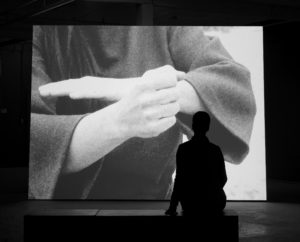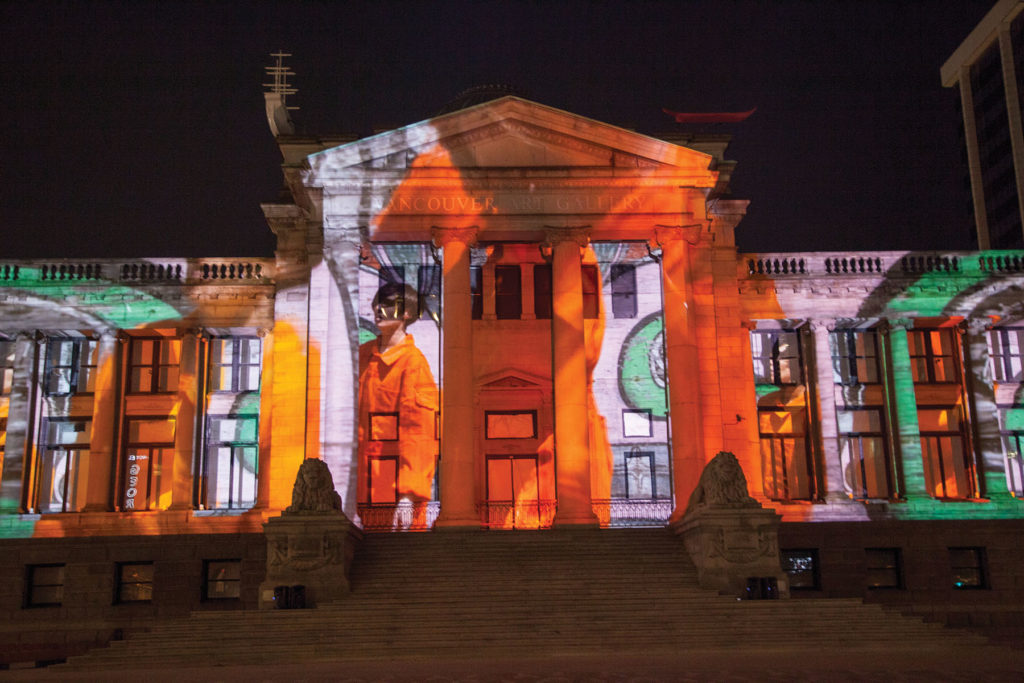The Evolving Story of Dance on Film: An overview of new forms then and now - Vancouver Ballet Society
- Home
- Features 2015 - 2019
- The Evolving Story of Dance on Film: An overview of new forms then and now

By Kathleen Smith
Dance on film as a standalone genre still felt new in the 1990s, when a kind of mini-Golden Era of activity occurred. Hybridity was a newish concept, and cultural institutions were anxious to appear progressive by embracing it. In Canada, dance and media collisions found regular support from the CBC, Bravo!FACT Foundation and various arts councils. Broadcasters such as BBC and Channel 4 in Britain, and NPS in the Netherlands — as well as many other cultural institutions in Europe, Australia and the Americas — were also funding and shaping the evolution of this kind of wordless storytelling.
Though it was definitely a niche scene, dance on screen seemed to be on a sturdy trajectory of engaged and growing audiences. Dedicated festivals popped up all over, and performing arts festivals expanded their mandates to include cinematic explorations of movement and choreography. When Marc Glassman and I founded the Moving Pictures Festival of Dance on Film and Video in 1992, presented annually in Toronto and with a national touring program, we were part of a small, but fairly well-funded international circuit devoted to exploring the intersections of dance for the camera.
By the mid 2000s, the bubble had burst. A period of intense disruption had led to great change on many levels. Funding and broadcast opportunities for dance on film dried up, and distribution systems and platforms transformed completely. Experimentation found a new home within the visual arts milieu. At the same time, the digital revolution was impacting everything to do with film and video making. New technologies such as virtual reality (VR), augmented reality (AR), mobile internet and social media appeared seemingly overnight. The terminology and discourse surrounding the body and media arts also became more investigative, with thinking about performance, dance, interactivity and the screen evolving and expanding across and between disciplines.
In the years since, the means of making and disseminating media work has become accessible to almost everyone in possession of a mobile phone. In the process, changing ideas about what art is, who makes it and how we experience it are broadening the scope of the creative process. The divide between arts institutions and the milieux they serve has widened, as innovation occurs daily, and funding bodies and cultural distributors struggle to keep up. Work with dance and the camera now also finds expression in museums and galleries as interactive screenings and installations. You can also find it on YouTube, Facebook and other social media platforms, on web channels, and at media, performance and film festivals of all kinds.

Hélène Lemay, Sandy Silva, Kimberly Robin and Bobby Thompson in Marlene Millar’s Pilgrimage
Photo: Taken on set by Jules de Niverville
But more doesn’t necessarily mean better. According to Marlene Millar, a Montreal-based filmmaker and former dancer, there is lots of “dodgy” work out there. “I often see films at a dancefilm festival that wouldn’t make it into a regular film festival,” she says, suggesting that “there are a lot of people who are just documenting their dance and then putting it out there … I think dancers are feeling the lack of audiences [in theatres] and with the easier access to technology want to capture their work on video to reach a much broader audience.”
Certainly volume can dilute the quality pool. And it’s true that dance artists are now familiar with video technology as an everyday choreographic tool in the studio, and also for self-promotion, presenting videos on their Facebook and Instagram feeds or company websites. Making and posting videos is standard procedure for independent artists of all stripes — no specialized training in filmmaking needed. There are bound to be a few clunkers in the mix.
But it’s also true that, in recent years, ideas about what is “good” in art have changed. In spite of a general persistent emphasis on production values, a slick, big-budget cultural product is only one type of outcome when it comes to artistic expression. The kind of work that a DIY aesthetic can hatch may be informal, upending viewer expectations over production values — and indeed this is now an attractive methodology both for experienced artists and a new generation of artistic creators who treasure rough edges and authenticity.
Filmmaker Laura Taler, whose award-winning dancefilms such as The Village Trilogy and Heartland heralded the beginning of the Canadian dancefilm boom, appreciates how artists with no formal filmmaking training are taking risks and making work that defies convention. “Sometimes not knowing what you’re doing is the best thing for making art.”
Taler finds that changes in the dance for camera landscape have been mostly liberating. “It’s a different playing field, people have smaller budgets now. That’s opened up opportunities for artists to ask ‘What am I really making?’ ‘How am I making it?’” she says.

HD video/Super 8 installation, Gallery 101, Ottawa
Photo: D. Barbour
“For 20 years, I made films for television essentially, which was great and I learned a lot. Now I’m not constrained by a 24-minute or a 43-minute time frame or needing to have a beginning, middle and end. Everything I’ve made since I stopped making films for TV has been on a loop. Even the idea of how I want to think about time has changed.”
Vancouver-based filmmaker Evann Siebens, an ex-dancer and accomplished cameraperson, also rode the dancefilm wave in the ’90s. Her current practice situates her closer to the visual arts world than to dance. Most recently, Orange Magpies, featuring dancers James Gnam and Vanessa Goodman, was projected on the façade of the Vancouver Art Gallery over several evenings. But Siebens’ dance experience continues to colour her ideas about filmmaking.
“In the filmmaking world, if you don’t storyboard, if you don’t have an entire film pre-visualized and drawn out, you’re seen as a ‘bad’ filmmaker,” she says. “In the contemporary dance world, if you come in with your dance completely written and storyboarded, then you’re seen as a ‘bad’ choreographer. It’s an interesting dilemma. I now have the experience and confidence to create a scenario and situation or environment, and then let the dancers and movers improvise and create. The performers who work this way love it, as it’s different from most film sets they’ve been on and is more in line with their dance practice.”

Photo: Courtesy of Evann Siebens
Film artists with a dance background, with their spatial intelligence and deep knowledge of body language, have much to contribute to new modes of cinema and media. In fact, they may be essential for the success of technology like VR, which tries to replicate sensory existence in an artificial environment.
The recent appointment of Winnipeg-based dance and media artist Freya Olafson to York University’s dance department as a professor in the area of screendance is another indication that, despite recent upheavals, using media and new technologies to explore ideas about the moving body is more important than ever for dance culture. Olafson’s pioneering practice includes live performance, video projections, VR and other digital art forms. (See more on Olafson on page 18.)
Still, most of the filmmakers I spoke with expressed wariness about technology, a skepticism that is at odds with funders’ current enthusiasms. Anne Troake, an artist and filmmaker based in St. John’s, Newfoundland, says, “I often see work made in service of showing what some innovative technology can do. When we’re so focused on figuring out a creation to fit the technology, it doesn’t serve the art. I try to be vigilant about the fetishization of technology, to keep the tools as tools.”

Photos: Taken on set by Christopher Darlington
Ironically, Troake’s last project was the 3D dancefilm OutSideIn, a 40-minute work featuring Carol Prieur and Bill Coleman. The team started working on the film at a time when 3D dancefilm seemed poised to be the next big thing (in part due to the mainstream success of Wim Wenders’ 3D documentary Pina, about choreographer Pina Bausch). But 3D distribution systems never reached critical mass and it seems unlikely to happen now that VR and AR have captured everyone’s attention.
Montreal-based filmmaker and presenter Priscilla Guy worries that new technologies are seducing both the institutions that provide funding and the artists who feel they have to follow the money. “I find it problematic in many ways,” she says, “because how these programs evolved was not through a reconsideration of what we value.”
Rather, Guy believes arts councils eagerly prioritize the latest digital technologies without truly understanding them. For her, this is not a neutral position; it’s political. “And it takes art-making even further away from real experimental research — which is what a lot of artists are actually doing.”
Guy admits she herself has misguidedly applied for funding for big technology projects. “It was such a relief when I didn’t get it, because I didn’t really want to do the project anyway.” It’s a laughably familiar scenario for many artists.
So what’s the real source of this continuing fascination for dance and movement expressed through media? It’s a relationship that began with 19th-century cultural pioneers such as the Lumière brothers, Georges Méliès, Thomas Edison and Eadweard Muybridge. Their early explorations of movement, photography and cinema set the tone for a century of experimentation. In the opening years of the 20th century, hand-painted films of dancer Loie Fuller demonstrated that light, movement and colour could be combined to create substantial choreographic impact. These early experiments were popular with the public, who loved watching movement on screen.
So were the later iterations of dance on screen in the ’30s, ’40s and ’50s — in musical numbers featuring Gene Kelly, Fred Astaire and Ginger Rogers, and the Nicholas Brothers, as well as films by Busby Berkeley. The mainstream appeal remains to this day with reality and competition television shows like So You Think You Can Dance, and feature films showcasing the world of dance, such as Black Swan and the Step Up franchise.

Photo: Courtesy of Priscilla Guy and Catherine Lavoie-Marcus
Strip away the gloss of sexy new technologies and the feel-good populism and we discover the unchanging heart of the matter is still choreography, still the moving body, ever a universally relatable concept.
According to Guy, “When I approach film from a choreographic perspective, it changes my focus, it changes what I’m looking at and how I’m looking at it. There are so many political, but also poetic, things that we can transmit through film if we’re able to shift our perspective from the narrative to the kinesthetic or from the narrative to the rhythmic — choreography helps us with that.”
Siebens gives dancefilm credit for expanding the cinematic experience. “I’m interested in breaking the frame,” she says, “in moving beyond the traditional two-dimensional space of film, in questioning the status quo. The visual transgressions of dance media, that on the surface seem so simple and pleasing, are an entry point for feminists and activists to have their say, an allowance for a complexity of politics, enabled by the moving body through time and space.”
Like-minded filmmakers and presenters around the world are clearly still interested. Despite what he sees as a lack of coherence in much of the dance media work in which new technologies feature, Philip Szporer thinks that “people are attempting to figure out how to present this work — as installations, projections, interactive displays, single-channel exhibits or works for the web. Partly that’s because older delivery systems like broadcasting just aren’t feasible anymore.”
Marlene Millar, who travels constantly to teach and support screenings of her films, says, “I even feel that there’s an explosion of new dancefilm festivals. I don’t know how they are managing, and a lot of them are quite small. But there are also events like Choreoscope in Barcelona, held in a really popular cinema in a great part of town, every night packed; it’s the best-attended dancefilm festival I’ve been to.”
Happily, almost two centuries on, the relationship between the moving body and the camera remains as vital as ever. It has spiraled in complexity, luring more artists, not just dance artists, into deep explorations of what it means to move and have a body, in more and different ways than would have seemed possible back in 1992.
“Work doesn’t have to be cutting edge,” says Laura Taler, “it just has to allow for things opening up — a dance/media work can be a five-minute screening in a theatre, but it can also be an installation on a loop, or something interactive. What’s interesting is the relationship between all those things.”

Photos: Taken on set by Christopher Darlington
